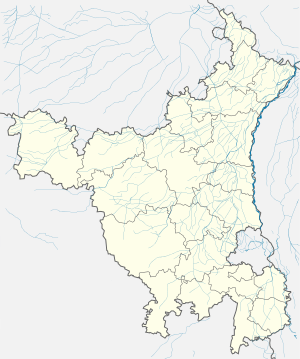Masani barrage
| Masani barrage & bridge | |
|---|---|
 Sahibi River at Delhi | |
 Location of Masani barrage & bridge in Haryana  Masani barrage (India) | |
| Country | India |
| Location | Masani in Rewari District |
| Coordinates | Coordinates: 28°12′17″N 76°43′45″E / 28.20481°N 76.729245°E |
| Status | Functional |
| Construction began | February 1979 |
| Opening date | 1989 |
Masani barrage, also Masani bridge, a barrage on the seasonal Sahibi River completed in 1989,[1] is named after the Masani village in Rewari District of Haryana in India.[2][3] Masani barrage also serves as a bridge on NH 919.[4]
History
It was built in 1970s,[5] on the seasonal Sahibi river which is 120 km long and flows from Aravalli hills in Rajasthan to South Haryana and Delhi.[3] After Sahibi river caused floods in 1977, then Prime Minister Morarji Desai mandated a flood control and water utilization master plan for the Sahibi river basin, consequently under which construction on Masani barrage commenced in February 1979 and completed in 1989.[1]
Barrage
Technical details
It lies in the Indian seismic zone IV.[6]
Usage
Barrage was built to provide irrigation facilities to 50,000 acres in Haryana, and flood protection to 1.60 lakh acres in Haryana and 40,000 acres in Delhi.[1]
Masani barrage is also used as the bridge on National highway NH 919 (former name NH 71B) which merges with national highway NH 48 (former name NH 8) (Delhi-Jaipur-Mumbai) at this barrage. Union govt announced the plan to four-lane the Masani barrage road (c. Aug 2017).[4]
Rajiv Gandhi Herbal Park and Nature Camp, Masani, was set up on floodplain of Masani barrage in 2011 by Haryana government to promote ecotourism. It entails a herbal conservation park, ayurveda center, wetlands and children park set up by the Forests Department, Haryana. Haryana Tourism has also made log huts accommodation, tree houses, nature trails and dining facilities.[7] Haryana Forest Development Corporation (HFDC) is building an adventure tourism centre, with a one km long ropeway, on 45 acres of land at Masani barrage (c. Mar 2017).[5]
Ecological concerns
1970s-80s plans to recharge the subsoil water (plunged to 100ft depth) vanished with the continual reduction in rainfall and construction of several dams over the Sahibi river in Rajasthan, resulting in basin of the Masani Barrage remaining dry since late 1980s.[1]
Entire 100 km stretch of Sahibi river and its streams (Sota River, Kotkasim drain and Indori river) in Haryana are ecologically dead.[3] Gurugram also dumps polluted discharge in the riverbed of Sahibi.[3]
Restoration
Government of Haryana is coordinating with Government of Rajasthan to ensure water reaches usually-dry masani barrage and dying seasonal Sahibi river. Another govt. project is being implemented to direct the extra water of Yamuna river during monsoon to Masani barrage through Jawahar Lal Nehru Canal and Western Yamuna Canal (c. July 2015).[2][1] In 2016, govt decided to disallow farming on 700 acre land around Masani barrage floodplain of Sahibi river, annually leased to the farmers since 1979, so that the land can be returned to the forest department.[8]
References
See also
External links
Citations
- 1 2 3 4 5 Masani Barrage: Boon or bane?, 19 Sept 2007.
- 1 2 "Centre of AIIMS to come up in Rewari district: Khattar .", Business Standard, 4 July 2015.
- 1 2 3 4 Haryana rivers profile
- 1 2 "Toll plaza on NH 8 to be shifted, says Nitin Gadkari.", Indian Express, 14 August 2017.
- 1 2 Ropeway for tourist pull at barrage site, Times of India, 17 Mar 2017.
- ↑ Masani barage
- ↑ "Haryana govt steps up efforts to promote eco-tourism.", Dna India, 11 May 2011.
- ↑ Fear of losing livelihood looms over 200 farmers, 16 June 2016.